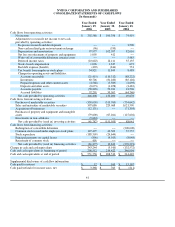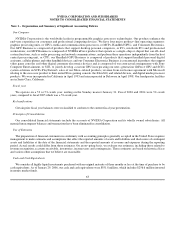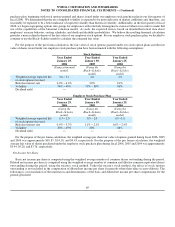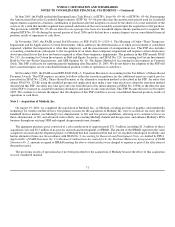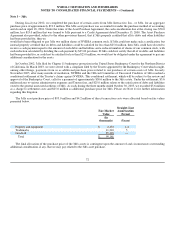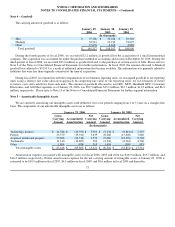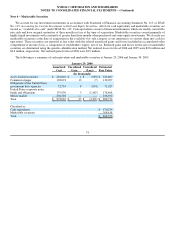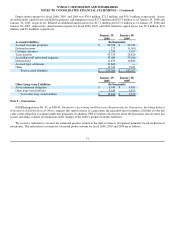NVIDIA 2006 Annual Report Download - page 79
Download and view the complete annual report
Please find page 79 of the 2006 NVIDIA annual report below. You can navigate through the pages in the report by either clicking on the pages listed below, or by using the keyword search tool below to find specific information within the annual report.
NVIDIA CORPORATION AND SUBSIDIARIES
NOTES TO CONSOLIDATED FINANCIAL STATEMENTS − (Continued)
In June 2005, the FASB ratified the Emerging Issues Task Force's, or EITF's, Issue No. 05−06, or EITF No. 05−06, Determining
the Amortization Period for Leasehold Improvements. EITF No. 05−06 provides that the amortization period used for leasehold
improvements acquired in a business combination or purchased after the inception of a lease be the shorter of (a) the useful life of the
assets or (b) a term that includes required lease periods and renewals that are reasonably assured upon the acquisition or the purchase.
The provisions of EITF No. 05−06 are effective on a prospective basis for leasehold improvements purchased or acquired. We
adopted EITF No. 05−06 during the second quarter of fiscal 2006 and it did not have a material impact on our consolidated financial
position, results of operations or cash flows.
In November 2005, the FASB issued Staff Position, or FSP, FAS115−1/124−1, The Meaning of Other−Than−Temporary
Impairment and Its Application to Certain Investments, which addresses the determination as to when an investment is considered
impaired, whether that impairment is other than temporary, and the measurement of an impairment loss. This FSP also includes
accounting considerations subsequent to the recognition of an other−than−temporary impairment and requires certain disclosures
about unrealized losses that have not been recognized as other−than−temporary impairments. The guidance in this FSP amends SFAS
No. 115, Accounting for Certain Investments in Debt and Equity Securities, and SFAS No. 124, Accounting for Certain Investments
Held by Not−for−Profit Organizations, and APB Opinion No. 18, The Equity Method of Accounting for Investments in Common
Stock. This FSP is effective for reporting periods beginning after December 15, 2005. We do not believe the adoption of this FSP will
have a material impact on our consolidated financial position, results of operations or cash flows.
In November 2005, the FASB issued FSP FAS123(R)−3, Transition Election to Accounting for the Tax Effects of Share−Based
Payment Awards. This FSP requires an entity to follow either the transition guidance for the additional−paid−in−capital pool as
prescribed in SFAS No. 123(R), Share−Based Payment, or the alternative transition method as described in the FSP. An entity that
adopts SFAS No. 123(R) using the modified prospective application may make a one−time election to adopt the transition method
described in this FSP. An entity may take up to one year from the later of its initial adoption of SFAS No. 123(R) or the effective date
of this FSP to evaluate its available transition alternatives and make its one−time election. This FSP became effective in November
2005. We continue to evaluate the impact that the adoption of this FSP could have on our consolidated financial position, results of
operations or cash flows.
Note 2 − Acquisition of MediaQ, Inc.
On August 19, 2003, we completed the acquisition of MediaQ, Inc., or MediaQ, a leading provider of graphics and multimedia
technology for wireless mobile devices. Our primary reasons for the acquisition of MediaQ, Inc. were to accelerate our entry into the
handheld devices market, use MediaQ's two−dimensional, or 2D, and low power capabilities, allowing us to continue to focus on
three−dimensional, or 3D, and advanced video efforts, use existing MediaQ channel and design wins, and enhance MediaQ's PDA
business through our existing OEM and original design manufacturer channels.
The aggregate purchase price consisted of cash consideration of approximately $71.3 million, including $1.3 million of direct
acquisition costs and $3.5 million of in−process research and development, or IPR&D, The amount of the IPR&D represents the value
assigned to research and development projects of MediaQ that had commenced but had not yet reached technological feasibility and
had no alternative future use. In accordance with SFAS No. 2, Accounting for Research and Development Costs, as clarified by FIN 4,
Applicability of FASB Statement No. 2 to Business Combinations Accounted for by the Purchase Method an interpretation of FASB
Statement No. 2, amounts assigned to IPR&D meeting the above−stated criteria were charged to expense as part of the allocation of
the purchase price.
The pro forma results of operations have not been presented for the acquisition of MediaQ because the effect of this acquisition
was not considered material.
71


